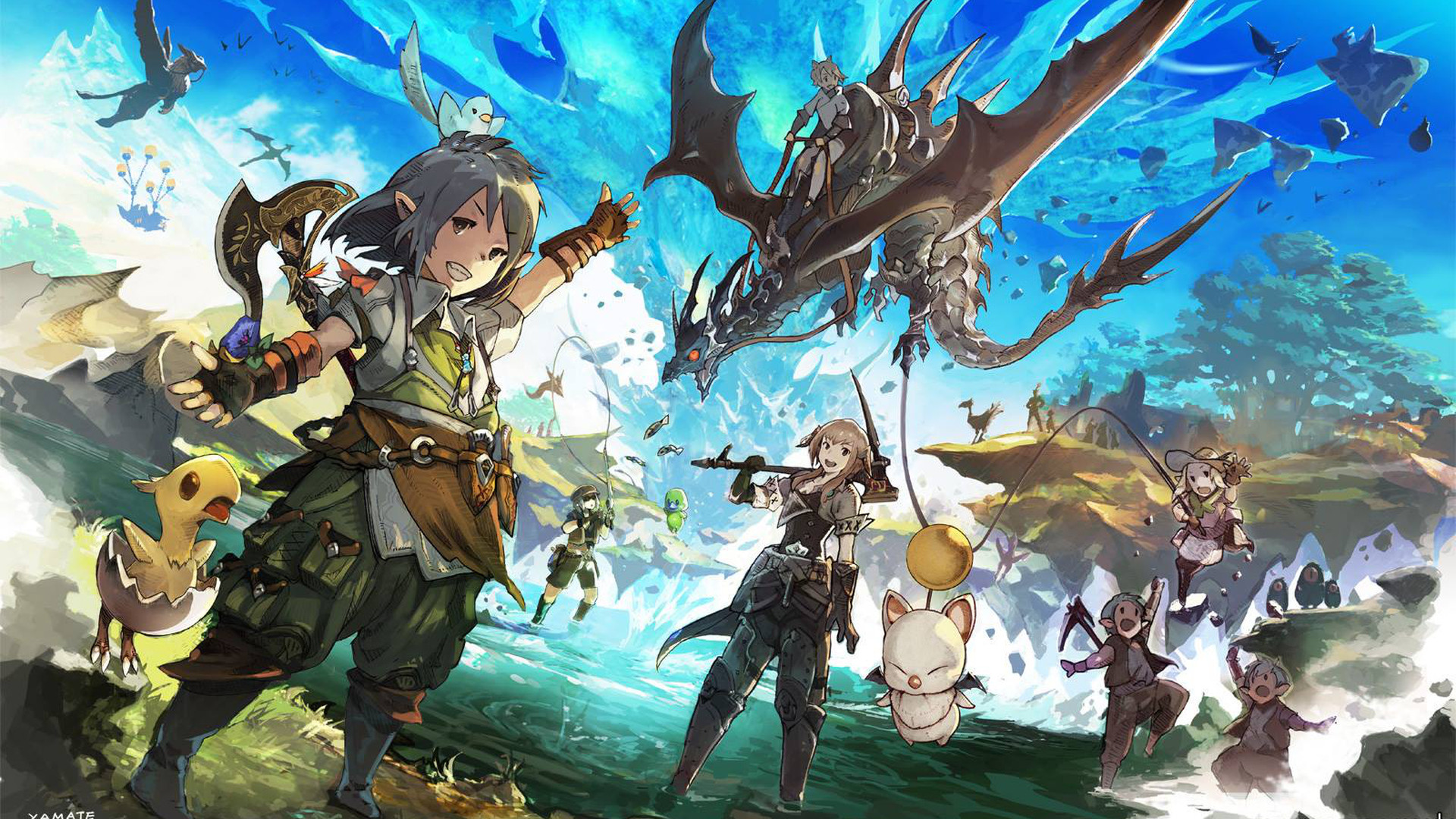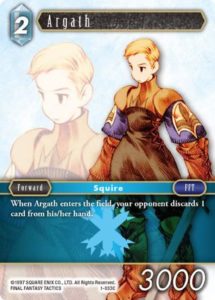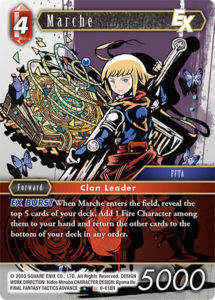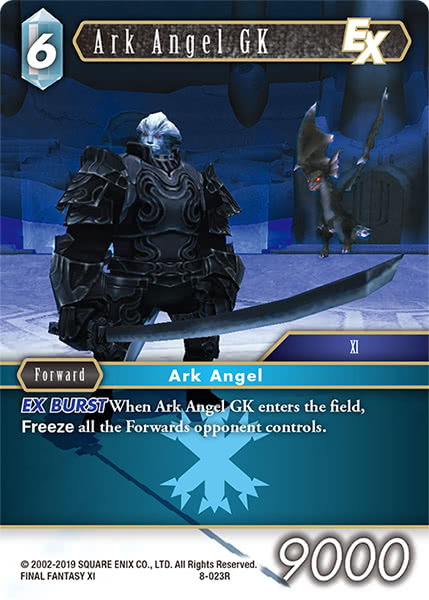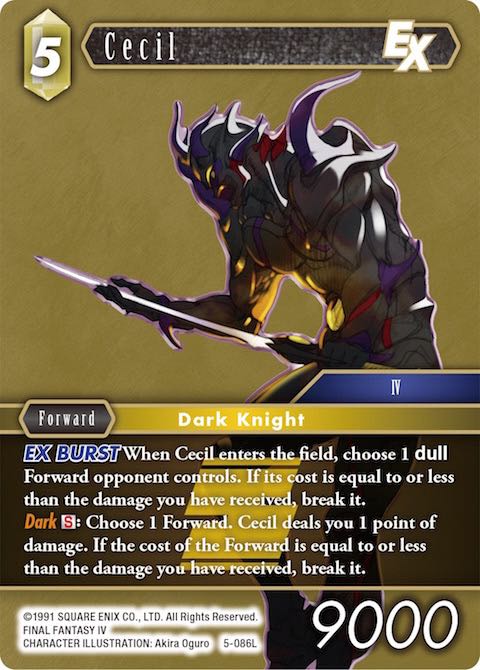So there’s been a tonne of discussion around Vayne recently on all the groups and in various channels, about how half of the game thinks he’s awesome, and half of the community thinks he’s room temperature trash. I’m firmly in the latter, and I wanted to give you guys a bit of insight on how I evaluate cards so you can understand why I think the new Vayne isn’t very good. When I talk about cards (IRL at least) I tend to talk about ‘Impact’ – which is basically a short term for ‘how much does this card affect the game-state before it dies,’ and usually cards with good ETB (enter the battlefield) effects have higher levels of Impact than ones that don’t. High-Impact cards have their value front-loaded into their on-play ability, so that even if they die virtually instantly, you don’t really care – this is important because going into a competitive tournament you should be prepared for literally the worst version of everything to happen, you want your deck to be consistent, and so that you never fall into the ‘I lost because I didn’t get set up’ mindset. Good decks can still go ham even under some degree of disruption.
For the purposes of this article, I’m only going to look at forwards, as good value backups are much more agreed-upon by the community-at-large, and also there’s less ways to mess with them in the game currently.
More after the jump.
Value vs Removal
To advance your game-state, you basically need to make sure that any spot removal your opponent uses on is basically not CP-favourable for them. If you play down a 5CP forward, proceed get no value off of it, and then it immediately gets Famfrit’d or Diabolos’d, you have lost 7CP worth of cards (5CP + the card itself) vs their 4CP for Famfrit (with Yuna out, let’s be real, it always is), or Diabolos at 2CP (Break a 5 cost, reactivate backups). That can’t sound good to anyone – for this reason, it’s important that every single card you play advances your game-state, while being mostly disposable. I’ve seen the argument “X is bad because it dies to removal, therefore every card is bad” thrown around online with VERY little thought behind it, and while it is true that every card can be removed in some way, GOOD cards get their value either before being removed, or by being removed. Let’s have a look at some of these cards below so hopefully people can have more informed opinions rather than resorting to incredibly dramatic hyperbole.
2-3 Costs – Early game swings
2-Cost high Impact forwards are often weirdly overlooked by the more middling to casual aspect of the community, with decks that seem to be built around getting a Boss Forward onto the field and then hoping their massive guy is going to be enough to win them the game. As I’ve mentioned in my article about Incremental Advantage, the early turns of a game are often the most important ones to make sure you play well, and running an optimal lineup of 2-3 forwards (and playing them at the most damaging moments) will definitely help get you towards a win.
Cid Raines/Lasswell
These guys can punish early aggro plays super hard. If your opponent happens to haste and swing an early forward, and you are in a position to Cid Raines (or Lasswell, potentially), you will likely go on to win that game. I myself have been hit by this, losing a Tifa and a card in hand to a lone Cid Raines, and I knew at that point unless I topped the absolute nuts, that that game was probably over. Outside of their entry effects, these two cards are 5k and 4k respectively, so you don’t really care if they get removed shortly after being played by something like Fina, as you’ve almost definitely got your value from them already. Plus if your opponent has had a really bad open and has had to play a 3 or 4CP turn one, Cid Raines combined with Lasswell can be devastatingly punishing.
Izana
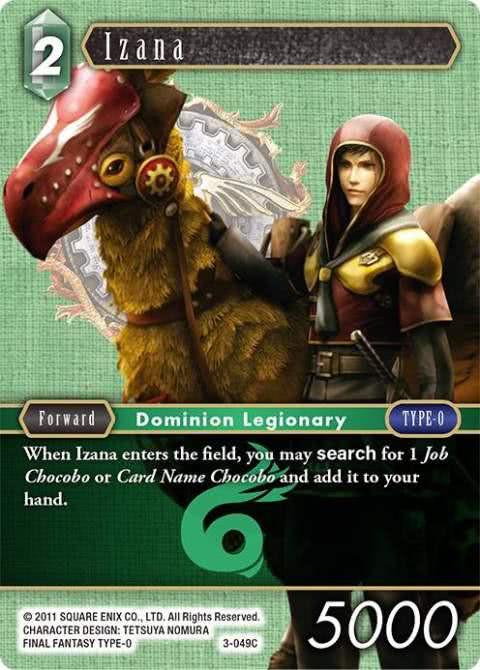
Izana isn’t high-Impact from affecting your opponent’s board, he’s high-Impact in affecting your own board by basically being a 2CP forward that appears for free (assuming you have a Chocobo in your deck, the searched card replaces him in your hand making him effectively free.) – I’ve never seen someone lose sleep over losing an Izana (except from in the intro to Type-0, rest in peace bby) after he’s done his search.
Palom/Argath
Palom & Argath are both fantastic, high-Impact early-game cards, as the discard on these cards makes it so that your opponent is effectively also paying for you to play this card (although less so in Palom’s case) – Yes, they both die to a stiff breeze, but once they have done their job, do you care? A common theme among all these two-cost forwards is you really don’t care if they die, and they also have the added bonus of being Famfrit-bait.
Urianger/Firion
These two might seem weird lumped in together at first, but these two are a little different to the other cards in this list as you REALLY don’t want them to die before they resolve their ETB effect – both these cards rely on the amount of forwards in play (Scions, in Urianger’s case) to determine what they do when they resolve. Outside of that though, these two 2CP cards can be extremely impactful on a board-state, with Firion removing things like Garland (IX) effectively free, and Urianger bringing things like Leyak, or Cactuar to the board for some really good value plays. If you really want to go all in, try bringing something like a Behemoth back with Urianger, and cry when it goes wrong.
Locke

Now Locke is slightly different from the other cards in this portion of the article – Locke is one you really do want to keep alive, as his Impact on the game only gets higher and higher with every attack he resolves – what really makes him a good early-game forward, is with even a tiny bit of setup, he does what cards like Serah do, but he has continued payoff the longer he’s down. With Locke coming down and losing your opponent a card in hand, he’s effectively a 1CP forward, in terms of investment vs return, at least. If he attacks and makes your opponent discard a card, he goes to -1CP. Second attack, -3CP. And so on. An unchecked Locke will win you the game, especially if you get Mirage Dived. Dove? No idea what the past tense of that would be. Locke is effectively the reason that Fire/Ice VI can open some disgusting swing plays and make you lose the game on turn 2-3. Do they care if you kill their Locke? Probably not, they have already gotten value off of it. And might Phoenix it back later. Good times.
Viking

Viking is the very definition of Low Cost, High-Impact. It might look like a non-threatening 2k, but drawing a card when he comes in makes him a 1CP 2k, and when he dies (not if he dies) makes him a -1CP 2k body. With Water wanting to get as many guys down as possible for Cagnazzo/Cloud of Darkness shenanigans, Viking plays perfectly into this. And it can be played off Leila for some reason. You want to Valefor/Fina down a field of Leila/Vikings vs water? Go for it – just be prepared for the 7-8 cards your opponent will start their next turn with. Viking essentially lets water accelerate the game by a full turn in terms of card draw, for an extremely low investment with extremely easy returns.
Zidane

Zidane is brutal. I’ve talked about this at length before, but the Impact of him hitting the board is HUGE. You get a sneak peak at what your opponent is playing, you get to take a card from their hand, and you have the potential of ruining combo plays or disrupting their curve. This card has absolutely no business being 3CP for the level of difference it can potentially have on a game, and I can assure you anyone that plays this wants it dead ASAP so they can play a second, or line up a Phoenix > Zidane play and really wreck your gameplan. Don’t think it’s an auto-win to just run this card, I’ve seen people make some really, really sub-optimal decisions with this card.
4 Costs – Mid-game value
Al-Cid

Ah yes, the OG Salt Value Bae. Al-Cid, for a 4CP investment, may be Old School, but man can he change a board. For the low, low price of 4CP, you can make your opponent lose a forward while you gain two. There isn’t a whole lot to say about this card, but it can really swing a game. He’s not as omnipresent as he previously has been, but is still a mainstay of Mono Lightning decks, and I can assure you not many Mono Lightning players are particularly heartbroken to ever see Al-Cid head to the break zone. Because it usually means a second one is coming down.
Genesis

Genesis is like Locke in that he accrues value throughout the game the longer he stays down, but his on-play value is slightly less quantifiable, while being less affected by the diminishing returns that discard sometimes is (ever discarded 1 with Sephiroth? Feels terrible.) Genesis also benefits by being in the break zone quite a bit in Devout builds, and can act like a “surprise, you’re dead” card if your opponent miscalculated their blockers in the very late game.
Celes

Similar to Genesis, but allows you to ruin a curve. Even if she gets instantly removed, if you’ve frozen a backup and stopped your opponent from making an efficient 3CP curve play, or even better, delayed that play for a turn, she’s bought you some massive value. The 4k on damage is also pretty relevant these days, killing a lot of early game forwards that may have already swung. Having an S ability also gives her a layer of protection that is relatively unique among 4CP 8ks, and can be hugely relevant at disrupting a big play from your opponent.
Duncan

When this card came out, I shat on it enthusiastically. I’ve recently given it a go and been a total convert to it. 4K ping on an 8k is not terrible at all (although the targeting restriction is really weird, lolfire). A sizable beater with a good burn on it, Duncan has no problem combo-burning down plenty of relevant targets or clearing annoying blockers just by entering the field. The fact that his S ability also promotes playing copies of a DIFFERENT card is just the icing on the cake, and as far as offensive ETBs fire has on a forward, Duncan is certainly up there. Kind of sad that he’s up there vs some other entrants on this list, but he’s up there.
Rufus/Marche
Much like Izana, these guys allow you to set up your next turn, while putting a forward on board. The general game-plan with these cards is either to chump block or bait block with them so that you can play another one as soon as possible, but Rufus has the added bonus of being to trade up to 10k (or to take out 2 5ks) when he dies in combat.
Noteworthy: Yuri/Wol
These guys are 4CP 8ks with pseudo-ETBs – they don’t need to stick around to get value. Ideally with Yuri you want to be playing it off of 2CP from backups, and 1 card in hand, just so you are able to use his effect immediately if you need to. It’s a fact of the game that Yuri will die incredibly quickly after he has come down, so putting yourself in a position to resolve him ASAP to recoup some of the CP you invested in playing him is certainly in your best interest. I have seen a disturbing amount of people playing Yuri off of 4 backups and then passing their turn, please stop doing this.
Wol is slightly different, but you can regain value on him instantly by simply playing him in MP1 and moving to combat, and applying his effects to another forward (or even something like attempting to give an opposing Illua brave to kill it with targeted removal afterwards). Because we don’t have to wait a full turn to see value off of Yuri and Wol, I thought them worth adding to the list.
5+ Costs – You must be this tall to ride
5 costs need to be pretty good to be worth playing, as they’re vulnerable to normal spot removal, as well as the dreaded, and ever-present Diabolos (and Alexander, if anyone plays that.)
Bartz
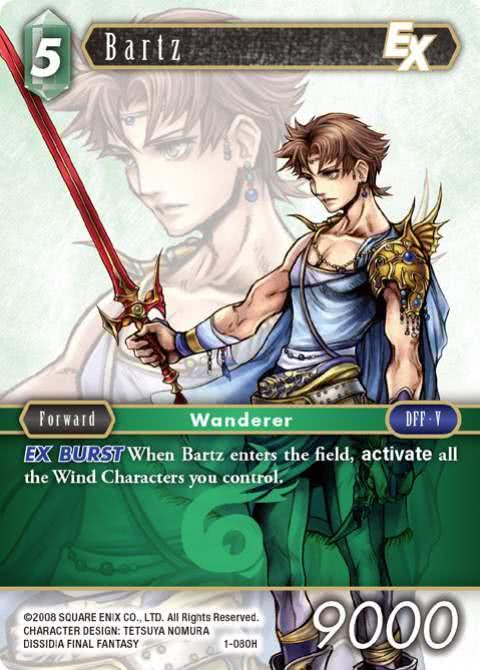
Bartz is a good card. Most 5CPs either need to be extremely efficient, have protection, or have REALLY high board Impact to be worth playing in anything approaching a competitive environment. Bartz certainly doesn’t have protection, but he can be really efficient, and allow you to attack with all your wind forwards and still have them active at the end of the turn. A Main Phase 2 Bartz off of backups is a terrifying play to see, and the person that played the Bartz isn’t going to mind too much if you commit something like a Diabolos to kill their 0CP forward. And if you don’t kill it, they’re just going to start beating you to death with it. Thanks Bartz!
Sephiroth

Sephiroth is a good card that gets misplayed a lot. I’d say it’s even an average card if it’s not followed up with a Rinoa or a Shadow Flare, and I’ve seen him cut from quite a few lists recently in Opus 8. Ideally you want to be dropping Sephiroth off of 3 or 5 backups, and you really want to resolve his S ability, Shadow Flare, or Rinoa on the following turns. If you get any attacks through with Sephiroth, bonus, but the majority of his value comes from him coming down early enough in the game that he’s more detrimental to your opponent than he is to you.
Fina

Fina’s kind of like Bartz, but with an alternate mode that allows her to wipe an aggro field or a field of weenie cards. Again, with all her value entirely front-loaded into her ETB, you’re not going to feel too bad about this card dying, and in fact it’s often encouraged that she doesn’t live to long so that you can play a second one if needed later in the game.
Cloud of Darkness
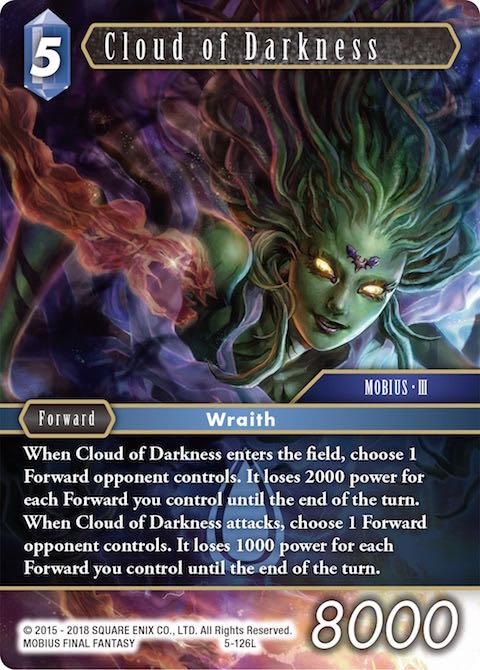
Cloud of Darkness falls into a similar category as Genesis and Locke, but much later game. Cloud of Darkness probably is killing something when it comes in, with a 6k-10k on an opposing forward being depressingly realistic vs the current (HA, LIKE WATER CURRENT) state that water is in. The fact that Cloud of Darkness starts deleting chump blockers every time it attacks makes incredibly valuable, but everything after that ETB effect should be seen as a bonus – she very much does the majority of her work simply by being played.
Lenna
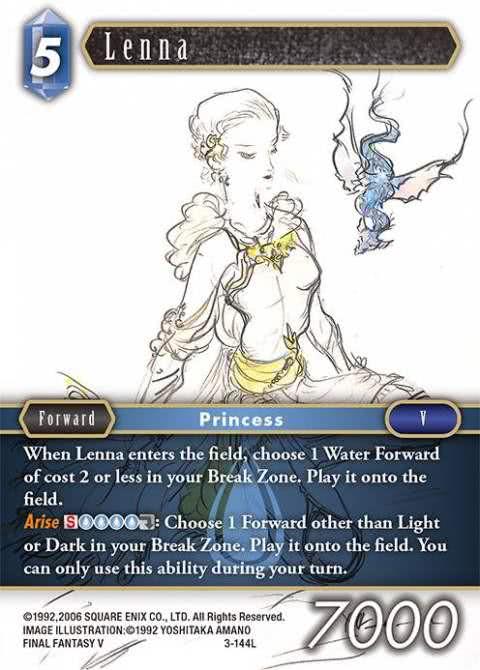
Lenna will pretty much always grab a Knight when played. In some fringe cases, a Zidane. In the majority of scenarios, Lenna is a “Pay 5 CP, play an 8k from your hand and a 9k from your break zone” – I can tell you from great experience that once the ETB has gone off, your opponent does not give a damn if you destroy Lenna, because of the incredible value it got them on play. If you break the Knight instead, they will get it back later with another Lenna. If you break the Lenna, you can expect them to play another Lenna. Think of it as an Al-Cid that doesn’t have to rely on your opponent to get the second forward down, and the second forward is often much larger.
Cloud

Cloud’s probably killing something when he comes in, and if you bother to spot remove him, he’ll probably just come back if he can kill another thing when he comes back. This one ticks the boxes for Impact, Efficiency and Protection, and is arguably the best forward Fire has access to right now.
Nidhogg

MY BOY! Nidhogg, if played at the right moment, can absolutely crush a game. The only board Nidhogg doesn’t get through is the Harigai Gullwings board, and taking a card from the opponent’s hand is also pretty ridiculous. I’ve had a lot of people say that the card is unplayable because it’s a 9 cost, but I strongly, strongly disagree, and think that Nidhogg is probably one of the highest-Impact forwards in the game. He can diffuse any threat on the field, and take a threat from the hand (randomly, so your opponent doesn’t even get to choose), and if he sticks around he’s a formidable 9k. If he doesn’t stick around, he’s definitely done his job. Say you hit a Veritas on field, deny it the exit effect as it’s been removed from the game, and hit a second card in hand that is 3CP or over in cost, you have gone value positive there, and have been left with a forward. If they want to waste a Diabolos or Famfrit on something that’s done it’s job, that is 100% fine by me.
Orphan/Kuja/Ark Angel GK
All three cards ETBs are powerful enough that they’re considered awesome Rinoa targets for repeating their ETB. Orphan can win games if dropped onto a late-game board, and if he’s not prioritized will have no problem keeping multiple forwards down for multiple turns. His value is front-loaded enough that even if he does get removed (and he will get removed, as his on-attack ability is really strong otherwise), he’s still been a decent investment, keeping 2 forwards dulled and frozen for an entire turn. Kuja acts the same as Genesis in terms of on-play value, but the 1 extra CP gets you access to an EX burst, 2k of extra power, and the ability to pitch backups to bring him back to your hand.
Ark Angel GK is just a huge potato with a good ETB.
Cid Aulstyne/Cecil
9k, 5CP beaters that can swing a game alone – breaking a forward on entry and providing an on curve body is always going to be hugely relevant in this game. Both have EX, so they promote running multiple copies, the difference being Cid Aulstyne capitalizes on an opponent who is already behind, whereas Cecil helps to level the playing field if you are behind. With both forwards, their value is largely in their on-play effects, so if either die, you’re just opening space up for another one. Dark on Cecil also has some neat applications with Noctis, allowing you to line up multiple breaks on that 6th point of damage.
Veritas of the Dark

Do I need to write more about Veritas? I’ll just get a lot of messages saying it’s broken and I should be calling for it to get banned. I’m not going to do that, the card is fine for the cost, and it’s easy to play around. Regardless, having both a removal ETB + removal exit effect, it’s easy to get great value out of this card, and is why it sees so much play in the current meta.
Sakura/Edea
Sakura and Edea are both interesting ones, as their design almost promotes them getting instantly removed with their extremely lackluster, nay, pants attack power. These cards are designed to die quickly, and get replaced quickly, but both have ways to get value even if they are staying on the field, with Sakura’s action ability allowing you to break a forward in Mono Lightning basically whenever you want, and Edea’s S ability, Death, doing the same thing.
Impact vs Risk
So, did you notice the pattern with the above cards? I wasn’t trying to be subtle with it, but there are two things that connect all the above cards:
- All these cards have seen play in a competitive environment this format
- All these cards can die while still having advanced the game-state the turn they came down
With that said, lets look at some other cards that have extremely powerful effects when you read them, but don’t see play (or at least as much play) due to some differences.
Ark Angel TT

Now Ark Angel TT’s effect is a little misleading. While he’s basically a free kill on virtually anything in the game, he’s definitely not going to survive that. If you’ve doomed an opponent’s forward to die with TT’s effect, they’re probably going to attack with that forward anyway – so either you need to have a bigger forward to block the thing Ark Angel TT is trying to kill (in which case the forward would die anyway), or you need to block with Ark Angel TT himself and effectively cause a trade. His most common use in the competitive scene is actually as throwaway CP for Star Sibyl.
Zemus

Zemus is one I’ve played myself in the past, but couldn’t recommend in the current metagame outside of some niche uses with Jake (who again, I would not recommend in the current meta). Zemus, the turn he is played, is a blank 4CP 8k. Which is not good. If you haste him with say, Red Mage (using 2CP to do so), you’ve already spent 6CP for the turn before you’ve even revived anything. However, if Zemus survives his first turn on the field (spoilers, he probably won’t), he can become incredibly powerful, allowing you to play forwards out of the break zone for effectively 2CP cheaper (as you’re not playing the forward from your hand). If you manage to start resolving Zemus, you will win that game. If you do not manage to start resolving Zemus, you’ve wasted 4CP, and potentially a turn, for nothing.
Vaan
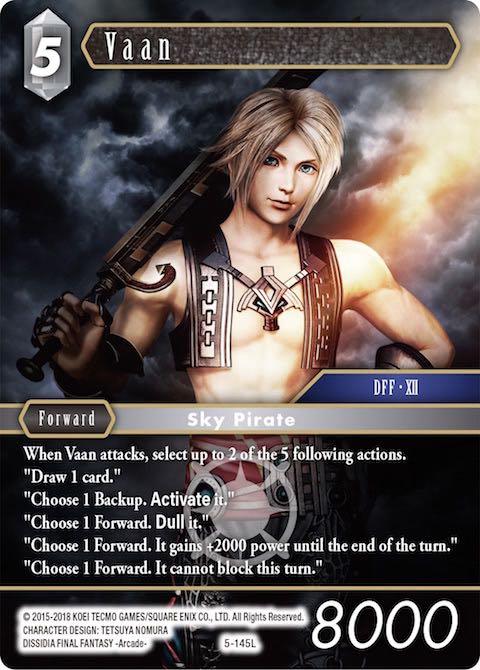
Vaan is another one I played for quite a bit, but ended up dropping as he’s blank before he gets a chance to attack. Unlike Wol, Vaan needs to declare an attack to actually get value. Being a 5CP 8k, he dies to a LOT of removal, and he has no innate potential at all, and being a Light card he’s extremely bricky. As with the above though, if you start resolving Vaan, you win as you’re effectively going to be bypassing 2 blockers, or bypassing 1 and drawing a card every turn.
Auron

Auron is the very embodiment of high roll – he does nothing when he is played onto the field, but when he starts inflicting damage, he can play backups from your hand onto the field, allowing fire to cast Vermilion Bird l’Cie Caetuna for free, or playing a backup searcher for free (with Dominion Legionary allowing you to set up multiple turns of this madness providing you are keeping the pressure up) – sounds good right? Doesn’t see any play though, due to the diminishing returns playing backups onto the field has, and the fact he has no ETB, or protection.
And that brings us to the punchline:
Vayne

Vayne is not an objectively good card. The main problem with Vayne is he needs a ridiculous amount of support to become even anything approaching playable, and a lot of people that I’ve seen leap to his defense seem to assume that they have infinite resources in a situation where they can play Vayne. I’ve seen arguments that following a Sephiroth, Vayne can be devastating, but that is assuming you have the resources to do a 7CP play followed by a 5CP play, and if you have those kind of resources, I do not see how that is a better play than Rinoa + Sephiroth or Sephiroth + Shadow Flare. I’ve seen a lot of people claim they will play it with Opus 1 Summoner (3CP, pay 1 CP and break to cancel a summon) to protect it, a card that didn’t even see much play in the Opus it released in, or that they will Tama it in in the end phase (cards cannot be played in the end phase), and this requires floating a lot of resources to do so, meaning that you probably didn’t have a proactive turn before hand. If there is a field worth dropping Vayne into (I’ve seen people say it’s good vs 4+ forwards), if your opponent doesn’t plan on paying to save those forwards, you can bet they’re just going to throw them at your Vayne to trade him down, or you’re going to have to let through 4+ damage. Doesn’t sound ideal. And this is assuming that Vayne makes it past his initial turn, all the way to the end of your opponents turn for the effect to go off – and even then they can simply just use the option to pay 1 CP to save them. Ultimecia isn’t a viable option either, as that implies you’re going to catch your opponent with all their backups tapped out, with a large field of 3+ forwards, and you’re going to drop Ultimecia and Vayne for a total of 15CP? (6CP + Ultimecia + 5CP + Vayne) – considering that Vayne’s “game breaking” ability goes away if he gets removed, I don’t really like the investment vs the return.
If Vayne had any kind of ETB, he’d be vastly superior, or even an S ability that could be used like his Opus 2 counterpart, but he doesn’t. He’s effectively blank until the end of your opponents next turn, and even then, his ability can just be paid for to avoid the effect entirely. The only reality I see Vayne being anything approaching usable in is a reality where he is a 5CP 7k back attack card with the same effect. We don’t live in that reality though, so I’m firmly branding Vayne as unusable. Unlike the above cards (in Impact vs Risk) we have no way to get instant value out of him with haste. I’ve seen arguments that your opponent isn’t always going to have removal – as a counterpoint, you’re not always going to have summon cancels, and I’ve seen people mention that it’s going to be a good 1-of in many Ice decks. Running it as a 1-of means you are going to see it at the perfect time less & less, and at time of writing there is no way to effectively bring him back without using something like Miner to pick him up and try again.
All these issues are further compounded when we consider that Ice has many better options with much more front-weighted value effects. What are you running this over? Kuja? Sephiroth? Orphan? Cecil (in ice/earth)? Cid Aulstyne?
Like it or not, relevant cards in FFTCG either have good Impact on play, or have protection to ensure that they live until they can start having Impact on the game. A card that comes down and doesn’t do anything for a full turn cycle, and even then can have it’s effect completely bypassed (if I have a field worth dropping Vayne into, I’m probably not going to bother playing any more forwards, and will instead keep them alive and attack repeatedly). At this moment of the game, I could not recommend anyone considers running Vayne, unless there’s a way to literally force the break aspect of his ability to be mandatory while protecting him.
What do you think about the important of ETBs? Am I way off the mark here? Is the real game based around slower cards with powerful, yet delayed abilities? Let me know in the comments down below, and as always, thanks for reading!
Esufer

